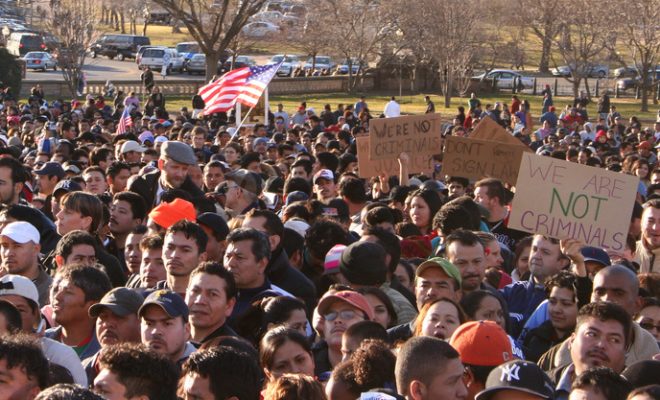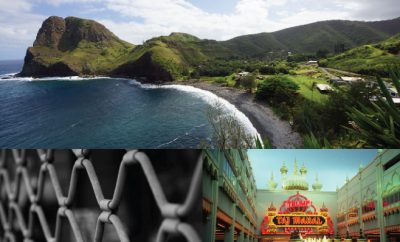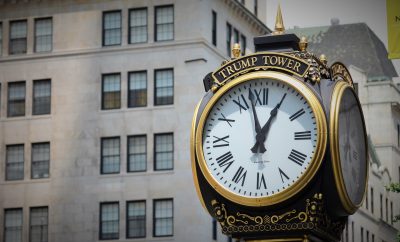 Image courtesy of David Tansey : License (CC BY 2.0)
Image courtesy of David Tansey : License (CC BY 2.0)
Politics
President Trump’s Order to Sanction Sanctuary Cities is Met with Resistance
President Trump has spent his first week advancing his hardline campaign promises by signing a slew of executive orders. On Wednesday, the president made his way to the Department of Homeland Security (DHS) where he signed two executive orders specifically related to immigration.
The first ordered the construction of his infamous wall along the southern border. The second order demanded federal agents implement more aggressive deportation practices, calls on Immigration and Customs Enforcement (ICE) to hire 10,000 new agents, allows local law enforcement officers to act as immigration officers, and, finally, block federal grants to so-called “sanctuary cities.” In spite of these developments, officials in sanctuary cities and jurisdictions are already standing in defiance.
According to the New York Times, four states, 364 counties, and 39 cities have laws on their books that limit the ability of local law enforcement agencies to cooperate with ICE and/or forbids local authorities from inquiring into one’s immigration status. When local authorities arrest someone, they fingerprint them and share the information with ICE. If ICE finds the detainee is undocumented, they ask local authorities to hold the person for 48 hours longer than they normally would. However, DHS has stated these detainer requests are optional as jailing an individual without a warrant violates the 4th Amendment. It seems the president, or more likely his advisors, are aware that they cannot legally force local jurisdictions to comply but that they can possibly coerce local jurisdictions into cooperation by imposing economic sanctions.
Executive orders are not policies in a typical sense and were traditionally implemented as a means of guiding existing laws rather than fabricating new, broad-sweeping ones. While President Trump’s orders are strong statements of intent, they are decidedly vague. There is no telling how much funding and what kinds of grants President Trump intends to deny to sanctuary jurisdictions. The Supreme Court ruled in South Dakota v. Dole that the federal government can restrict funding to indirectly achieve federal objectives, but those mandates cannot be “unduly coercive.” While this may prevent the Trump administration from halting all funding, defiant jurisdictions risk massive and unexpected cuts.
Concerned officials in Washington, D.C. warned that, depending on what the Trump administration decides is constitutionally “reasonable,” the city’s budget could be slashed considerably. Due to its unique status, the District has perhaps the most to lose. Nevertheless, the president’s coercive anti-immigrant order will gravely affect any and every sanctuary jurisdiction.
The president claims that the damage he intends to inflict on communities across the country is in defense of the country at large. Since the campaign, it is clear that President Trump’s anti-immigrant stand is grounded in a long-standing stereotype that immigrants, particularly undocumented immigrants, bring crime. In his speech at DHS headquarters, President Trump stood in front of a crowd that included the family members of people killed by undocumented immigrants to whom he gestured while claiming his measures would save “thousands and thousands of lives.” Additionally, the preamble of his executive order states that sanctuary jurisdictions “have caused immeasurable harm to the American people and to the very fabric of our Republic.” However, the “harm” caused by sanctuary cities and undocumented immigrants can be, and has been, measured.
Political scientists at the University of California at Riverside and Highline College found that sanctuary jurisdictions saw no statistically significant change in crime following the passage of sanctuary laws. Furthermore, a study by the American Immigration Council found that “immigrants are less likely to commit serious crimes or be behind bars than the native-born, and high rates of immigration are associated with lower rates of violent crime and property crime.” And these facts do not even consider discrimination in the American criminal justice system. A large body of research has shown that Latinos, and people of color in general, are disproportionately arrested and convicted. Moreover, once convicted, people of color face longer sentences than white people found guilty of the same crimes.
President Trump’s attack on sanctuaries has already met resistance, and so it is possible that funding for hundreds of communities will drastically diminish. These sanctions will place a huge strain on communities throughout the country for no good reason at all. President Trump is well aware that these communities provide a safer environment for undocumented people. Perhaps he’s forgotten that they are also home to Americans he promised to “never let down.”








Comments